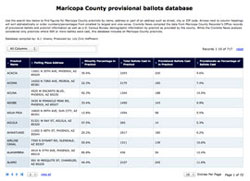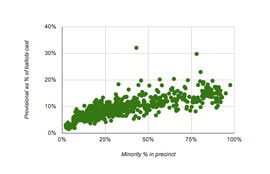Cronkite News has moved to a new home at cronkitenews.azpbs.org. Use this site to search archives from 2011 to May 2015. You can search the new site for current stories.
Analysis: In precincts with higher minority populations, greater chance of casting provisional ballots
PHOENIX — Maricopa County voters living in precincts with higher percentages of minorities had a greater chance of casting provisional ballots in the Nov. 6 election, a Cronkite News Service analysis found.
The statistical analysis drew upon a precinct-level summary of provisional ballots from the Maricopa County Recorder’s Office and precinct-level demographic data prepared by the U.S. Census Bureau and provided by the county to a reporter.
It found a strong relationship between provisional ballots as a percentage of total ballots in a precinct and the precinct’s percentage of minorities. That is, the likelihood that voters would cast provisional ballots tended to increase with a precinct’s minority population.
There were about 123,000 provisional ballots cast in Maricopa County, of which 23,000, or 19 percent, were declared invalid.
Hispanic rights groups have criticized what they characterize as large numbers of provisional ballots in precincts with large minority populations.
“That has been our worry,” said Francisco Heredia, state director of Mi Familia Vota. “There should be some safeguards (to the voting process), of course, but it should be as easy as possible for every eligible individual that is registered to vote and cast a ballot.”
Provisional ballots are designed to ensure people don’t vote twice or don’t vote when they’re not eligible. They’re given to voters when their names don’t appear on a precinct’s list of those registered to vote.
About 172,000 provisional ballots were cast statewide, representing 7.4 percent of the overall vote.
Rep. Chad Campbell, D-Phoenix, the House minority leader, has said he plans to introduce legislation that would create a committee to examine Arizona’s overall voting system. He said he’s concerned about the number of provisional ballots cast and whether minorities were disproportionately affected.
“It doesn’t matter what community you’re talking about,” Campbell said. “If there’s a community being forced to vote more provisional ballots than other areas it’s more likely you’ll have your vote tossed. It’s a backdoor way of voter suppression. Unintentional or intentional, it’s still voter suppression in some way, shape or form.”
Neither Secretary of State Ken Bennett nor Maricopa County Recorder Helen Purcell responded to multiple requests for comment on the analysis.
In releasing the official election canvass Monday, Bennett’s office said that many of the provisional ballots were used because voters who were mailed ballots showed up at polling places instead.
Yvonne Reed, a spokeswoman for the Maricopa County Elections Department, sent an email pointing a reporter to a briefing Wednesday presenting the department’s own analysis of the election. Reed’s email also said, “I seriously suspect your data may not be correct,” but she didn’t respond to requests for an explanation.
The Cronkite News Service analysis doesn’t point to a reason that precincts with higher percentages of minorities tended to have higher percentages of provisional ballots cast. It also doesn’t show whether minorities cast those provisional ballots.
Rodolfo Espino, an Arizona State University political science professor, said the anticipation of a flood of new Hispanic voters could have led the county to recruit new poll workers who weren’t trained properly, leading to increased use of provisional ballots.
Additionally, he pointed to a push by groups to not only register new voters but sign them up to cast early ballots. That was a response to the state law created by Proposition 200 requiring voters to show identification such as a driver’s license or passport at polling places.
“The reason being is because of the Prop. 200 requirements, a lot of these organizations recognize that certain segments of the population are hit harder disproportionately in terms of meeting these voter ID requirements, Native Americans and Hispanics specifically,” Espino said.
Espino said he heard from multiple voters who tried to hand in early ballots at precincts on election day, as allowed by state law, but found that poll workers wouldn’t accept them. Those voters were given provisional ballots instead, he said.
Jeanne Simons, a Democratic committeewoman in the Holly precinct a few miles northeast of downtown Phoenix, said she didn’t know why that precinct, which is 82 percent minority, had 18.5 percent of all ballots cast as provisionals. However, she said the line to vote “was out the door” at 6:30 p.m. when she dropped off her early ballot.
Phil Amorosi, a Democratic committeeman in Tempe’s Hudson precinct, where 43 percent of residents are minority, said the 32 percent provisional ballots cast there was probably due to the large population of college students. But the problems at that precinct went beyond confused college students, he said.
“I saw people down there that I know have lived in the neighborhood for 30 years and they were being told they needed to do the provisional ballot, and these are regular voters that know what to do,” Amorosi said. “Definitely the county needs to do a much better job of publicizing vote by mail and what it entails.”
Roopali Desai, a Phoenix attorney who represents Promise Arizona, a Latino voting and civil rights group, said the organization is running its own investigation into provisional ballots to determine what happened on election day. Higher percentages of provisional ballots in higher-minority areas, perhaps a result of poorly trained workers, may not have been intentional but still could be discriminatory, she said.
“There’s a group of people that the county is overlooking when they keep defaulting to, ‘We need this procedure in place to protect our system,’” Desai said. “That’s true, but there’s a whole group of people here that aren’t a threat to the system, they didn’t already vote by early ballot and their name should have been on the precinct list, and they were at the right polling place or they should have been sent to the right polling place instead of being told to vote provisional by the poll worker.”
Joseph Garcia, director of the Latino Public Policy Center at Arizona State University’s Morrison Institute for Public Policy, said he understands the suspicion by some advocacy groups based on the state’s political climate and the fact that Maricopa County listed the wrong election date on some Spanish language materials. But he said he doubts there was a coordinated suppression effort.
“The whole idea of the conspiracy against Latino voters, when it comes to the Secretary of State’s Office and Maricopa County, I don’t think they’re that smart and I don’t think they’re that dumb that they would do that,” he said.









